|
 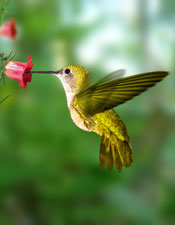
Bold and Beautiful: Hummingbirds bear the most glittering plumage and some of the most elegant adornments in the bird world. Male hummingbirds are usually brightly coloured. The females of most species are duller.
The names that admiring naturalists have given to hummingbirds suggest exquisite, fairylike grace and gemlike brilliance. Fiery-tailed Awlbill, Ruby-topaz Hummingbird, Glittering-bellied Emerald, Brazilian Ruby, Green-crowned Brilliant, Festive Coquette, Shining Sunbeam, and Amethyst-throated Sunangel are some of the names applied to birds in this group.
Size: The Bee Hummingbird (Mellisuga helenae) is the smallest bird in the world, weighing 1.8 grams. A more typical medium-sized hummingbird, such as the Rufous-tailed, weighs approximately 3 g and has a length of 10-12 cm (3.5-4 inches).

Diet: Hummingbirds are attracted to many flowering plants, including shrimp plants, Heliconia, bromeliads, verbenas, fuchsias, many penstemons—especially those with red flowers. They feed on the nectar of these plants and are important pollinators, especially of deep-throated flowers. Most species of hummingbird also take insects, especially when feeding young.
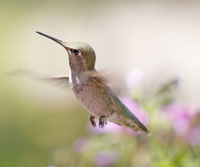 Flight: Hummingbird flight has been studied intensively from an aerodynamic perspective: Hovering hummingbirds may be filmed using high-speed video cameras. Writing in Nature, biophysicist Douglas Warrick and coworkers studied the Rufous Hummingbird, Selasphorus rufus, in a wind tunnel using particle image velocimetry techniques and investigated the lift generated on the bird's upstroke and downstroke. Flight: Hummingbird flight has been studied intensively from an aerodynamic perspective: Hovering hummingbirds may be filmed using high-speed video cameras. Writing in Nature, biophysicist Douglas Warrick and coworkers studied the Rufous Hummingbird, Selasphorus rufus, in a wind tunnel using particle image velocimetry techniques and investigated the lift generated on the bird's upstroke and downstroke.
They concluded that their subjects produced 75% of their weight support during the downstroke and 25% during the upstroke: many earlier studies had assumed (implicitly or explicitly) that lift was generated equally during the two phases of the wingbeat cycle. This finding shows that hummingbirds' hovering is similar to that of hovering insects such as the hawk moths. The differences result from an inherently dissimilar avian body plan.
Metabolism: With the exception of insects, Hummingbirds in flight have the highest metabolism of all animals, in order to support the rapid beating of their wings. Their heartbeat can reach as high as 1260 beats per minute, a rate once measured in a Blue-throated hummingbird. They also typically consume more than their own weight in food each day, and to do that they have to visit hundreds of flowers daily. At any given moment, they are only hours away from starving. However, they are capable of slowing down their metabolism at night, or any other time food is not readily available. They enter a hibernation-like state known as torpor. During torpor, the heartrate and rate of breathing are both slowed dramatically (the heartrate to roughly 50-180 beats per minute), reducing their need for food.
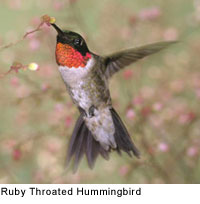 Studies of hummingbirds' metabolism are highly relevant to the question of whether a migrating Ruby-throated Hummingbird can cross 800 km (500 miles) of the Gulf of Mexico on a nonstop flight, as field observations suggest it does. This hummingbird, like other birds preparing to migrate, stores up fat to serve as fuel, thereby augmenting its weight by as much as 40 to 50 percent and hence increasing the bird's potential flying time. (Skutch, 1973) Studies of hummingbirds' metabolism are highly relevant to the question of whether a migrating Ruby-throated Hummingbird can cross 800 km (500 miles) of the Gulf of Mexico on a nonstop flight, as field observations suggest it does. This hummingbird, like other birds preparing to migrate, stores up fat to serve as fuel, thereby augmenting its weight by as much as 40 to 50 percent and hence increasing the bird's potential flying time. (Skutch, 1973)
Range: Hummingbirds are found only in
the Americas, from southern Alaska and
Canada to Tierra del Fuego, including the West Indies. The majority of species occur in tropical Central and South America, but several species also breed in temperate areas. Excluding vagrants, sometimes from Cuba or the Bahamas, only the migratory Ruby-throated Hummingbird breeds in eastern North America. The Black-chinned Hummingbird, its close relative and another migrant, is the most widespread and common species in the western United States and Canada.
Migration: Most hummingbirds of the U.S. and Canada migrate to warmer climates in the northern winter, though some remain in the warmest coastal regions. The Rufous Hummingbird shows an increasing trend to migrate east to winter in the eastern United States, rather than south to Central America, as a result of increasing survival prospects provided by artificial feeders in gardens. In the past, individuals that migrated east would usually die, but now many survive, and their changed migration direction is inherited by their offspring. Provided sufficient food and shelter is available, they are surprisingly hardy, able to tolerate temperatures down to at least -20°C.
Hummingbirds owe their wide distribution to their great power of flight and wandering habits no less than to their hardiness.
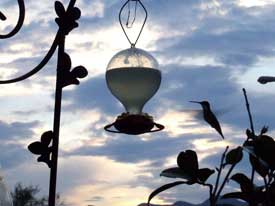 Hummingbirds and people: Many people enjoy attracting hummingbirds by offering feeders, taking pleasure in observing the colourful birds. Hummingbirds and people: Many people enjoy attracting hummingbirds by offering feeders, taking pleasure in observing the colourful birds.
Hummingbirds will use man-made feeders, particularly red ones. A suitable artificial nectar consists of one part sugar to four parts water. It is easiest to dissolve the sugar in boiling water, then cool it completely before putting it out for the birds.
Measuring the water and adding the sugar after removing the water from the heat source will ensure an accurate ratio. Sweet foods other than white sugar, such as honey, ferment too quickly and may cause them harm. Some commercial hummingbird foods are available, but they contain red dyes, which are unnecessary. They also contain small amounts of nutrients, but hummingbirds get their nutrients from the insects they eat, not from nectar, so the added nutrients are also unnecessary. Thus, plain white (pure granulated cane) sugar and water make the best artificial nectar.
A feeder should be rinsed and the water changed weekly, or every two to three days in warm weather. Because mold is deadly to hummingbirds, feeders should be soaked in a solution of chlorine bleach at least once a month, or sooner if black mold appears. Hummingbirds tend to avoid feeders that have been cleaned with soap, because of its taste, so it's best to flush them well with warm tap water.
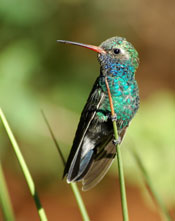 When Hummingbirds Get Trapped... Hummingbirds sometimes fly into garages and become trapped. It is widely believed that this is because they mistake the hanging (usually red-color) door-release handle for a flower, although hummingbirds can also get trapped in enclosures that do not contain anything red. Once inside, they may be unable to escape because their natural instinct when threatened or trapped is to fly upward. This is a life-threatening situation for hummingbirds, as they can become exhausted and die in a relatively short period of time, possibly as little as an hour. If a trapped hummingbird is within reach, it can often be caught gently and released outdoors. It will lie quietly in the space between cupped hands until released. When Hummingbirds Get Trapped... Hummingbirds sometimes fly into garages and become trapped. It is widely believed that this is because they mistake the hanging (usually red-color) door-release handle for a flower, although hummingbirds can also get trapped in enclosures that do not contain anything red. Once inside, they may be unable to escape because their natural instinct when threatened or trapped is to fly upward. This is a life-threatening situation for hummingbirds, as they can become exhausted and die in a relatively short period of time, possibly as little as an hour. If a trapped hummingbird is within reach, it can often be caught gently and released outdoors. It will lie quietly in the space between cupped hands until released.
If the bird is too high to reach, a possibility is to close the garage door and turn out the lights. It will land, and can be found using a flashlight and thus released.
 Most male hummingbirds take no part in nesting. Most species make a neatly woven cup in a tree branch. Two white eggs are laid, which despite being the smallest of all bird eggs, are in fact large relative to the hummingbird's adult size. Incubation is typically 14-19 days. Most male hummingbirds take no part in nesting. Most species make a neatly woven cup in a tree branch. Two white eggs are laid, which despite being the smallest of all bird eggs, are in fact large relative to the hummingbird's adult size. Incubation is typically 14-19 days.

Classification: Traditionally, hummingbirds were placed in the order Apodiformes, which also contains the swifts. In the modern Sibley-Ahlquist taxonomy, hummingbirds are separated as a new order, Trochiliformes.
 There are between 325 and 340 species of hummingbird, depending on taxonomic viewpoint, divided into two subfamilies, the hermits (subfamily Phaethornithinae, 34 species in six genera), and the typical hummingbirds (subfamily Trochilinae, all the others). There are between 325 and 340 species of hummingbird, depending on taxonomic viewpoint, divided into two subfamilies, the hermits (subfamily Phaethornithinae, 34 species in six genera), and the typical hummingbirds (subfamily Trochilinae, all the others).
Evolution: Hummingbirds are thought by evolutionary biologists to have evolved in South America, and the great majority of the species are found there. All of the most common North American species are thought to be of relatively recent origin, and are therefore (following the usual procedure of lists starting with more 'ancestral' species and ending with the most recent) listed close to the end of the list.
Genetic analysis has indicated that hummingbirds diverged from other birds 30 to 40 million years ago, but fossil evidence has proved elusive. Fossil hummingbirds have been found as old as a million years, but until recently, older fossils had not been securely identifiable as hummingbirds. Then, in 2004, Dr. Gerald Mayr of the Senkenberg Natural History Museum in Frankfurt am Main identified two 30-million-year-old German hummingbird fossils and published his results in Nature. The fossils of this extinct hummingbird species, Eurotrochilus inexpectatus ("unexpected European hummingbird"), had been sitting in a museum drawer in Stuttgart. They had been unearthed in a clay pit in Frauenweiler, south of Heidelberg.
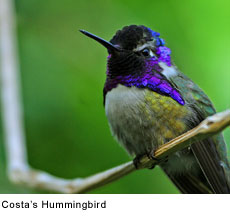 Mythology and Culture: Mythology and Culture:
-- The Aztec god Huitzilopochtli is often depicted as a hummingbird.
--
One of the Nazca Lines depicts a hummingbird.
--
The Ohlone tells the story of how a Hummingbird brought fire to the world.
All text is available under the terms
of the GNU Free Documentation License
|